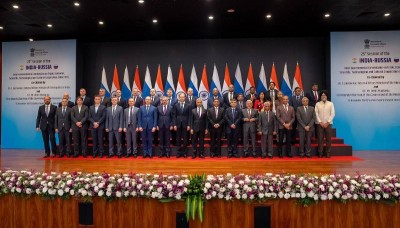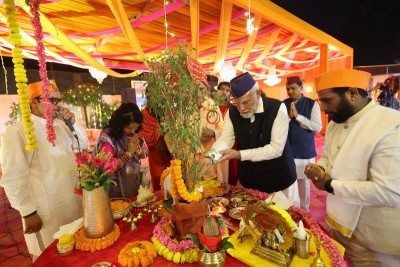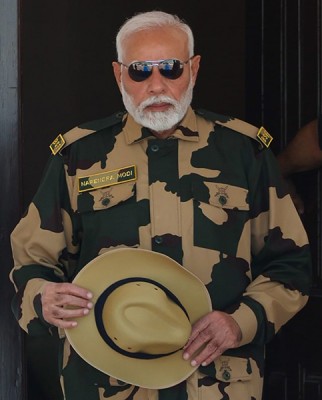
Arunachal Pradesh: Towards Sustainable Peace
On April 26, 2015, Security Forces (SFs) killed an unidentified militant of the Arunachal Pradesh Depressed People's Front (APDPF) in the Deban area of Changlang District. SFs also arrested six militants of the group. APDPF was formed in 2014 by some Chakma youths principally to engage in extortion, abduction, and other criminal activities, in the Diyun, Miao and Namsai areas of Changlang and Namsai Districts. The group has approximately 10 to 12 cadres who had undergone armed training in Bangladesh in 2014.
These were the only militant fatalities at the hands of the SFs through 2015. In 2014, SFs killed six militants in four separate incidents.
SFs lost four of their personnel in two separate incidents in 2015. In a major [resulting in three or more fatalities] incident, three Army personnel were killed and another four were wounded in an ambush when cadres of the Isak-Muivah faction of National Socialist Council of Nagaland (NSCN-IM) fired on their convoy at Tupi village, along the Khonsa-Longding road, in Tirap District on April 2, 2015. The ambush was carried out by the NSCN-IM to 'avenge' the killing and arrests of its cadres by SFs in Arunachal Pradesh. Four NSCN-IM cadres were killed and another four were arrested in the State through 2014. According to the Arunachal Pradesh Police, NSCN-IM militants including self-styled 'sergeant major' Ayo Tangkhul, 'captain' Kapai aka Singmayo Kapai, 'lieutenant' Ami Tangkhul, 'lieutenant colonel' Kewang Hassik, 'major' Anok Wangsu and 'sergeant major' Chenaye Tangkhul aka Ayo, were suspected to have carried out the attack with the help of some local villagers.
In another attack targeting AR personnel, militants carried out an Improvised Explosive Device (IED) attack at Monmao village, near the India-Myanmar border, in the Changlang District, on February 6, 2015. Two civilian porters working for AR were killed, while nine AR troopers were injured in the blast. One of the injured AR trooper succumbed to his injuries the next day. Later, NSCN-K sources claimed that the attack was a joint operation by the NSCN-K and the Independent faction of the United Liberation Front of Asom (ULFA-I), against the Indian Army.
The SFs also had a lucky escape as two suspected NSCN-K militants, including a Myanmar national, were killed and another was injured, when an IED they were trying to plant exploded accidentally at Wakka, near the Indo-Myanmar border, in Longding District on June 9, 2015. The selection of the spot for planting the IED suggests that the militants had AR personnel and their assets in mind as targets, since an AR outpost is located about eight kilometers away. A live IED, along with a remote control, was recovered from the site of the incident.
Earlier, on June 7, 2015, around 30 to 35 heavily armed NSCN-K militants had opened fire at an AR camp in the Lazu area of Tirap District bordering Myanmar. There was no report of any casualty, as alert AR personnel retaliated immediately and effectively, forcing the militants to flee. Around 70 empty AK-47 cartridges and some unexploded bombs were recovered from the incident site.
Significantly, Arunachal Pradesh had not recorded any SF fatality through 2014. In fact, the last SF fatality dated back to October 25, 2007, when three AR personnel and a civilian were killed and another eight were injured in an ambush carried out by NSCN-IM militants in a remote jungle in the Tirap District.
The State did not witness a single attack targeting civilians through 2015. However, two civilian porters were killed in the February 6 attack targeting AR personnel. In 2014, three civilians had been killed in two separate incidents. In 2014, two civilians were killed in crossfire between AR personnel and militants at Holam village in Khonsa in the Tirap District on January 2, 2014. In the second incident, a trader from Kerala was found dead in a jungle in the Cheputa village in Papum Pare District on September 5, 2014, after he had been abducted a week earlier, on August 27, 2014. These civilian killings were recorded in Arunachal Pradesh after an almost six year gap, since October 25, 2007.
According to partial data compiled by the South Asia Terrorism Portal (SATP), Arunachal Pradesh has recorded a total of 10 insurgency-related fatalities, including two civilians, four SF personnel and four militants, through 2015 (data till December 31), as against nine fatalities (three civilians and six militants) in 2014. Overall security environment in the State thus remained more or less stable. Insurgency in Arunachal peaked in 2001, with 63 fatalities, including 40 civilians, 12 SF personnel and 11 militants.
SFs also arrested a total of 21 militants in 10 separate incidents in 2015, as against 19 such arrests in eight separate incidents in 2014. 11 of the arrested militants belonged to Arunachal Pradesh-based outfits - seven of the APDPF and four of the National Liberation Council of Tani Land (NLCT). Three arrested militants belonged to Nagaland-based outfits - two of NSCN (faction not known) and one of NSCN-IM. One militant belonged to the Assam-based National Democratic Front of Bodoland (NDFB). Affiliations of the remaining six militant's arrested remained unconfirmed.
According to the Union Ministry of Home Affairs (UMHA) data, as on September 15, 2015, abductions in the States of the Northeast registered a significant decline in 2015, with Arunachal Pradesh showing a nearly 50 per cent drop in incidents of abduction, from 49 in 2014 to 24 in 2015. NSCN-K was responsible for the maximum number of recorded incidents, followed by NSCN-Khole Kitovi (NSCN-KK).
Arunachal has long remained 'an island of relative peace' in India's troubled Northeast, though it has been affected, for some years, by an 'overflow' of violence from neighboring States. Crucially, all the incidents of killing through 2015 were reported from three eastern Districts - Tirap, Changlang and Longding - which border Nagaland and are regarded as sanctuaries by Naga militant outfits NSCN-IM and NSCN-K. Crucially, these three Districts are part of NSCN-IM's projected State of Nagalim(Greater Nagaland).
Through an order issued on November 4-5, 2015, UMHA further extended the Armed Forces Special Powers Act (AFSPA) in 16 Police Stations of Arunachal Pradesh for six months, citing the presence of Naga insurgent groups including NSCN-K, NSCN-KK and the Reformation faction of NSCN (NSCN-R) besides Assam based terror outfits ULFA-I and the IK Songbijit faction of the NDFB (NDFB-IKS), to declare these Districts "disturbed areas" under section 3 of AFSPA. AFSPA was first implemented in these three Districts on September 17, 1991. Significantly, of the five incidents of killing reported in 2015, NSCN-K was responsible for three; while NSCN-IM and APDPF were responsible for one each, clearly demonstrating that the preponderance of violence was coming from neighbouring States. This 'overflow' is a major concern.
Assam-based Bodo militant groups also pose a security threat to Arunachal Pradesh, especially along the Arunachal-Assam border. A UMHA notification of March 27, 2015 observed,
a further review of the law and order situation in entire districts in Assam bordering Arunachal Pradesh reveals that areas lying within the police stations in Arunachal Pradesh bordering Assam remain a cause of serious concern. There is presence of NDFB-S, NSCN-IM, NSCN-K, ULFA-I, Kamtapur Liberation Organization (KLO), Manipur People's Liberation Front (MPLF) along the Assam-Arunachal Pradesh border. Outfits like Kanglei Yawol Kanna Lup (KYKL), United National Liberation Front (UNLF), People's Liberation Army (PLA) and Kangleipak Communist Party (KCP) are helping NDFB-S and ULFA-I and KLO for movement of men, material, infiltration and exfiltration.
Accordingly, AFSPA had been extended to nine new Districts of Arunachal through the notification on March 27. However, on May 5, 2015, the Government changed its decision and AFSPA was lifted from these Districts.
Arunachal Pradesh also faces the problem of the illegal influx and settlement of foreigners, especially the presence of the 53,000 strong Chakma and Hajong refugees that has created a sense of marginalization among indigenous tribes like the Noctes, Wangchow, Khamtis, Singphos and Tsangas in the eastern-most part of Arunachal; while in the western part of the State, Tibetans, Bhutanese and Nepalese are exerting demographic dominance over the indigenous Monpas, Sherdukpens, Akas and Mijis. Further, in central part of the State, there is a floating population of Bangladeshis that has created tension among Nyishi, Adi, Galo, Apatani and Tagin tribes.
Significantly, on September 17, 2015, the Supreme Court (SC) directed the Union Government and the State Government to grant citizenship to Chakma and Hajong refugees within three months. The State Government filed a review petition on October 26, 2015, aggrieved at the SC's decision. Though the Supreme Court rejected the State Government's application on November 19, 2015, the Arunachal Pradesh Government has again decided to file a curative petition in respect to the permanent settlement of Chakma and Hajong refugees in the State. On November 23, 2015, Chief Minister Nabam Tuki noted, "We are not against the grant of Indian citizenship to the Chakma, Hajong refugees, but opposed to their permanent settlement in Arunachal Pradesh and the exemption from the Inner Line Permit".
While Arunachal Pradesh has been relatively free of the widespread insurgencies that have afflicted much of India's Northeast, patterns of militant overflow and demographic destabilization do create significant security challenges in this sensitive border State, which require enhancement of the capacity and quality of the SFs deployed. According to a report published on April 8, 2015, UMHA had already given an 'in principle' nod to raise 16 additional battalions of the Indo Tibetan Border Police (ITBP) Force, of which 8,000 personnel (about eight battalions) would be deployed in the Northeast, mainly in Arunachal Pradesh. Also, between the 2012-13 and 2014-15 fiscal years, Arunachal Pradesh received INR 730 million under the Security Related Expenditure (SRE) scheme to strengthen its Police network. In addition to an unprecedented strengthening of SF capacities in the State, accelerated development initiatives in the fields of infrastructure and economy, are also necessary if a sustainable peace is to be established.
Support Our Journalism
We cannot do without you.. your contribution supports unbiased journalism
IBNS is not driven by any ism- not wokeism, not racism, not skewed secularism, not hyper right-wing or left liberal ideals, nor by any hardline religious beliefs or hyper nationalism. We want to serve you good old objective news, as they are. We do not judge or preach. We let people decide for themselves. We only try to present factual and well-sourced news.







